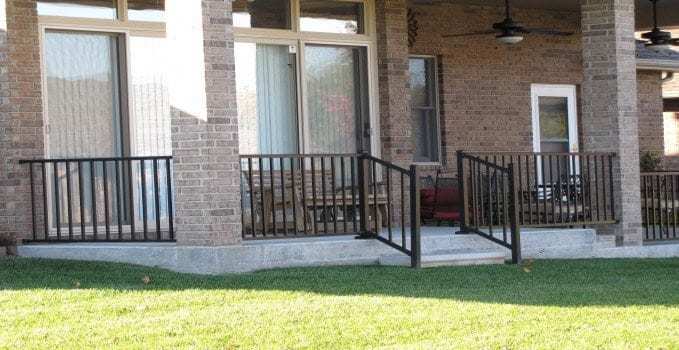MMC Blog
Parts of a Railing System
Last Updated: August 7, 2017
Balusters, treads, newels, lattice . . . No, I’m not speaking a foreign language. I’m referring to some of the parts of a railing system (as well as related products, like stairs). Although you’re probably familiar with some railing terms, like rail and post, others might make you scratch your head in confusion. So if you’re planning to purchase or install a new railing, read through the terms below to ensure that you know your balusters from your posts and your hinges from your post caps.
Parts of a Railing System
Baluster
A baluster is a short and decorative post, pillar, or column in a series that supports the top rail. You may hear a baluster referred to as a spindle, picket, or banister. The term baluster comes from the Italian word for pomegranate flowers, balaustra, which was chosen because these architectural features sometimes mimic the blossoms with their bulbous, stylish shapes. Balusters can be made of wood, iron, or stone, amongst other materials.
Balustrade
A balustrade is a railing supported by a series of balusters. Balustrades are sometimes short and ornamental parapets (low, protective walls) found on balconies and terraces. Their balusters are evenly spaced and supported by posts. Sometimes balustrades are used to define a space, like the balustrade that surrounds the bed in the king’s bedchamber in the Palace of Versailles.
Bottom Rail
A bottom rail is the lower, bar-like component of a railing. It runs parallel to the floor and supports balusters/spindles, which hold up the top rail. Some railings do not contain bottom rails, as the balusters run into the flooring.
Guardrail
Guardrails protect people from dangerous situations by ensuring that they cannot accidentally fall off an elevated place, such as a platform, walkway, stair, or landing. They can be found in buildings, on roads, along hiking trails, on staircases, on balconies, etc. Guardrails contain, at minimum, posts, balusters, and a top rail. They must be strong enough to resist breaking or falling if a person falls or pushes against the structure. Sometimes they are combined with handrails to ensure that the railing both offers stability and acts as a barrier.
Handrail
Handrails are designed to be grasped by the hand for physical stability, support, or guidance. They are typically supported by posts or mounted directly to walls, and they ensure that if someone slips or missteps, they won’t won’t fall down. For this reason, they are commonly found on stairs, platforms, and walkways. Handrails only need to be strong enough to act as a stable, continuous guide. Sometimes they are combined with guardrails to ensure that the railing offers stability and acts as a barrier.
Hinge
A hinge is a moveable, mechanical joint that allows a railing’s gate to swing open. One side of the hinge is attached to the stationary railing; the other side is attached to the gate.
Landing
Landings are large, flat surfaces where people can stand. They are found at the top of a flight of stairs, so they can be at the peak of a staircase or in the middle (between two flights). Although some railing systems don’t have landings, all stairways do.
Lattice
Lattice is a structure in which strips of wood (or metal, vinyl, etc.) are crossed and fastened together. The design creates a square- or diamond-shaped pattern. Latticework can support climbing flowers or vines. Some railings have lattice panels between the posts instead of balusters, or they may support a lattice above the top rail. Of the parts of a railing system listed here, lattice is the most inessential and uncommon, but it does offer aesthetic appeal.
Newel Posts
Newels are the large, vertical posts at the head and foot of a flight of stairs. They support the handrails, providing strength. When a newel is located on a landing, it is sometimes called a landing newel.
Post
A post is a vertical structure that supports a railing, and it is one of the most critical parts of a railing system. Without posts, the railing would lack strength. Newels are types of posts.
Post Cap
A post cap is an object designed to cover the top of a post. It can be used for decorative purposes as well as utilitarian; for example, it can keep out rain, bugs, sand, and debris. Sometimes post caps are called finials.
Rail
A rail is a horizontal bar, typically fixed on posts, that forms the top or bottom section of a railing. The rail acts as a guard or barrier.
Railing
A railing is a barrier system formed of posts, balusters, and rails. The term railing is sometimes shortened to rail.
Spindle
See Baluster.
Top Rail
A top rail is the upper, bar-like component of a railing. It runs parallel to the floor and sits atop balusters/spindles.
Tread
The tread is the horizontal, top surface of a step or stair. It is the structure on which people step.
*Please note that some of these terms have alternate definitions. We’re focusing only on their use within the railing industry.
_____
Now that you know the various parts of a railing system, why not dive in and install your own railing? As long as you’re patient, use the right tools, and follow the product’s directions, it’s a simple and straightforward process.
And if you’re planning to purchase a new vinyl or aluminum railing, be sure to check out MMC Fencing & Railing. You might be interested in the Westbury Aluminum Railing systems, which are available in a variety of styles and colors. With names like Tuscany, Riviera, Montego, and Veranda, you can trust that these railings are both elegant and understated. Or, if you would prefer classic, traditional styles, check out the PolyRail and TRX vinyl railing systems. Both aluminum and vinyl are dependable, long-lasting, and maintenance-free railing materials, and they come in a large assortment of colors and styles.
For more information, please check out the MMC Fencing & Railing online store or give us a call at 1-866-931-5002 for more information.



